|
TennisOne Lessons Torque Action on the Serve Doug King If I've said it once I've said it a thousand times, appearances can be deceiving. Nowhere is this more evident than on the serve. In watching the top servers in the game, we can't help but notice the tremendous racquet speed that is generated and power released on the ball. When we go out and try to duplicate it, we often have disastrous results. The ball may fly all over the court and in many cases we even end up losing power on our shots. In fact, we find an inverse relationship, that is the harder we swing the more power we end up losing. This phenomenon is called "over swinging" and it is a very common mistake. Even some pros (primarily on the women's tour) are guilty of it. On the other hand there are players who unleash incredible power with somehow contrary technique. Look at Sampras and his unusually short follow-through, or Roddick and his incredibly short backswing. The key to great serving certainly isn't in the emphasis of either of those two aspects of the motion. May I suggest another consideration and that is the interplay of opposing forces – or more commonly referred to as "snap," but what may more accurately involve torque.
Torque
Loading and Unloading – Opposing Force Interplay The throwing motion, like the serve motion, is based upon various forces
including rotational twists. Think of how a novice throws a ball. Everything
moves in one direction towards the target. There is little wind up (rotation on
a horizontal plane), little leg or back bend, and no shoulder rotation on top.
This is the same case on the serve. We call this a "push" serve or a "frying pan"
hit. Instead we should endeavor to choreograph a series of winds and unwinds, bends and straightenings, delays and whips, and changes of directions.
It is not simple – too complex to cover in one article or one lesson – but let's
look at a couple of specifics that can add more power and control to your
motion.
The loading process requires strength and flexibility to "deform" the body out of its natural or relaxed state. There are two significant "opposing force" flexes in the body – one is the arching of the back (lower body pushed forward and upper body held back) and second is the twist of the right side and the left side (left side forward and right side held back). You can feel both of these "loads" by mimicking the serve motion and feeling the push out of the hips and at the end of this arch, try to pull your shoulders together behind you. As you drive out of the legs and go up into the ball, you should try to hold the arch in the back and spread open the rib cage at the same time. This works the body into a "dual plane" spring tension. These two springs will "snap" back into alignment (both the back straightening and the shoulders closing back in together) in a synchronized movement that will add to and be reflected by the snap of the arm on top.
The more load you can build, the more stored energy you can release on the ball. This is why strength training and flexibility work are so important on the serve. The Unloading – Putting On the Brakes At this point where the chest has thrust forward and the racquet has flexed back
to optimum load, the unloading immediately follows. This actually begins with a
push back and up in the abdomen and chest and occurs just prior to the contact.
Most people make the mistake of trying to increase the forward swing of the arm
by continuing to swing the torso forward. This does not create torque and does
not realize the full potential of acceleration in the racquet. The
release of the load starts not with a release from the arm but a reversal of the
arch in the back. I
have described this action in my earlier piece on the topspin backhand as pulling the hitting cord. The same thing occurs on
the service action. It is a timed expansion of the entire right side of the body
that ends up with an accelerated reverse of the racquet position at the top. If
too much forward movement is emphasized, two negative things will result; one, proper acceleration won't occur (as you need a stopping component to
achieve acceleration) and secondly, it will be difficult to achieve lift of the body as it will tend to collapse downward.
Most people swing the arm forward too fast to allow the elbow to stay fixed in the correct position above the shoulder and produce rotation of the arm to finalize the "snap" on top. This fast arm swing pulls the arm down before the arm can produce a proper rotation on the top, resulting in maximum acceleration. The Small Things Add Up Evidence of the application of torque and the interplay of opposing forces is evidenced in many aspects of the serve. The way the left hand works up pull into the body through the contact is a torque maneuver. It helps to stop the forward action of the body and increase acceleration of the racquet and pinpoint it to a more specific point. This stopping action is a critical part of passing the energy properly along the kinetic chain. Think of how your hand would work on the handle of a bullwhip to produce a ripple of energy that passes along the whip cord. If there is only forward movement on the handle, then there is no whip produced. It is only the stopping and subtle reversal of the handle that creates that “bubble” of energy. This works the same way on the serve. If you can imagine your body as the handle of the whip and your arm as the cord, there is a very delicate directional coordination and timing of the action to produce a powerful pop of energy at the top. Where the body stops its forward rotation will create a natural point where the arm will tend to snap. If the body goes beyond this point the body is essentially taken out of the shot and the arm is working more independently of the body.
Keep in mind that this is not just a “wrist snap.” It is what I call a “full body snap” as almost all elements of the body work in unison to contribute to the power. The arm must swing in rhythm with the body. It should only swing as fast as the legs and the back direct it. What happens very commonly is that people try to get the hand involved in the serve at too early a stage during the motion. This can happen (and often does) at the very beginning of the serve when players tend to flick the racquet back and up, or the arm swings away too far. This is usually because people are trying to feel the swing of the racquet. They want to sense where the racquet is and they want to feel that it is swinging and building up speed. In reality the racquet should be held totally passive and the racquet head should be the last thing that is felt in the motion. Although you don’t want the wrist sloppy or whippy, you do want to keep the wrist very relaxed on the handle throughout the serve. Wrist action should be reserved for the very last moment. By adhering to the Continental grip on the serve this will eliminate disruptive wrist action in the backswing that tends to spray the arm and racquet which causes a loss of racquet awareness.
There will be a natural firming of the grip at contact. Don’t think of the racquet going back in a “swinging” action as much as the elbow feeling a clearly defined path that has reference points along the way. Notice in the examples above how top servers take the racquet back with a passive wrist. They all show clearly defined points where the elbow bends to change direction and compact the swing. This not only helps to keep a consistent swing path but also is critical in loading the legs and torso properly. What we often see in lesser servers is much more hurried or extended backswings that produce inconsistent backswings and even disruptions of the ball toss. When these torque movements are applied in a well timed series of actions the result is not only better acceleration at the correct moment of the stroke but it is also produces a stabilizing of the body as these opposing forces tend to cancel each other out. The body is actually more quiet through the hit and finishes up in much better balance on the finish. The Swim Model The use of the left hand as described above creates a stopping action to the right side of the body and helps it to change from linear movement to rotational movement. In golf they call this "hitting against your left side" and the same thing occurs on the serve. The idea is to get the shoulders as vertical as possible as you approach the ball and roll the right shoulder over the top of the left shoulder.
Try to keep the left side of the body down and in so that it
constricts the free swinging action of the right arm. Instead of letting the
right arm swing freely it will help to facilitate a forceful rotation of the
shoulder and forearm which will produce the correct rotational acceleration on
contact. It should resemble a freestyle swim stroke, top shoulder lifting,
rolling and rotating over the bottom shoulder. It should also hold the head in a
similar position as though taking a breath, tilted up and looking back
slightly. Like in swimming this helps to lift the body out of the "chop" and
into the hit. With the racquet cocked back and down, go into your hit and just before contact try to produce a twisting in the upper arm that snaps the point of the elbow up and back. This should drive the right shoulder up and into the right ear through the hit. Add a push up and back with the right hip as you make this action. This will give you the feel of "climbing" on top of the serve. Keep the hand and wrist relaxed through your practice. The wrist should be relatively passive and respond to the actions of the arm and body. The main thing you want to feel I the hand is simply holding back and then letting go just prior to the hit. "Let" the wrist snap occur naturally. Trying to add wrist will often sabotage proper loading and unloading.
As you add the legs into the serve use them to create a spring up into the ball
and out into the court while at the same time maintaining a live arm action on
the hit. Realize that acceleration at the top of the swing is what you are really after and the way to achieve this is to work with opposing forces throughout the serve to both properly load and unload on the ball. The action is a full body "snap" that will result in a "squaring up" at contact with maximum force applied to the ball at that moment. Think of adding a little more "backwards" in your serve to move your game forward. Your comments are welcome. Let us know what you think about Doug King's article by emailing us here at TennisOne.
Doug is one of the country's foremost tennis teaching innovators. Founder of Acceleration Tennis, a revolutionary teaching system, King is leading the way in reinterpreting the traditional tennis model. Doug King is currently Director of Tennis at Meadowood Napa Valley ( www.meadowood.com ), a Relaix Chateau Resort in St. Helena , CA . For more information on Acceleration Tennis please email Doug King at dking@meadowood.com. |

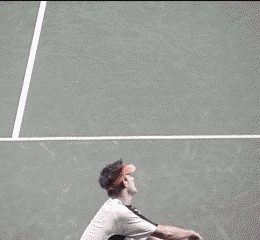
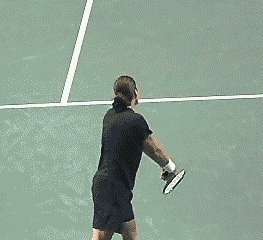
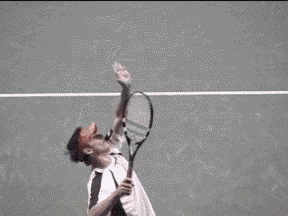
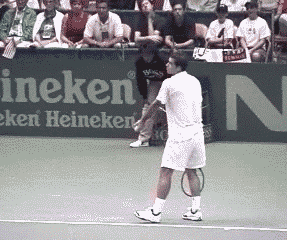
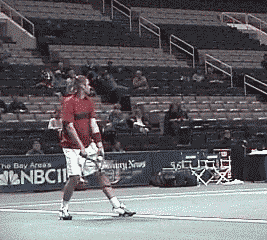
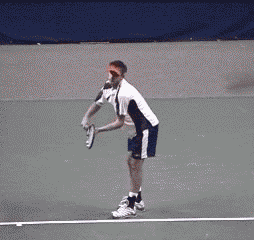
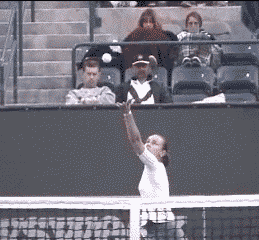

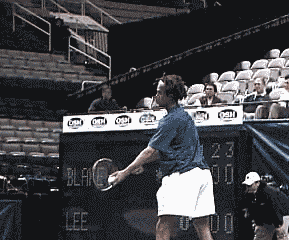
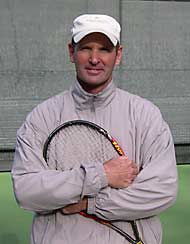
 Doug King studied with legendary tennis coach Tom Stow and was a
former California State Men's Singles Champion
and the former number one men's player of Northern California.
Doug King studied with legendary tennis coach Tom Stow and was a
former California State Men's Singles Champion
and the former number one men's player of Northern California.